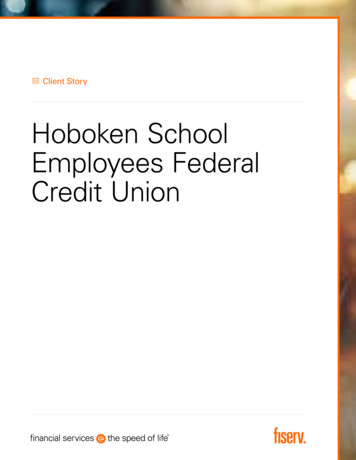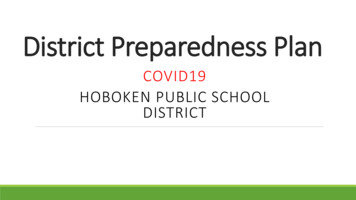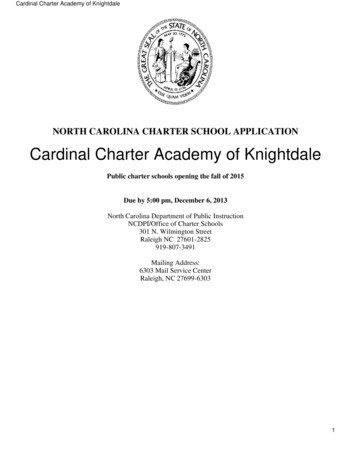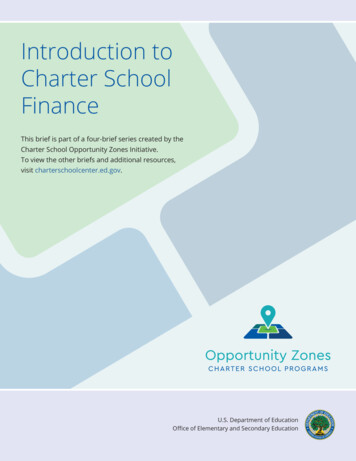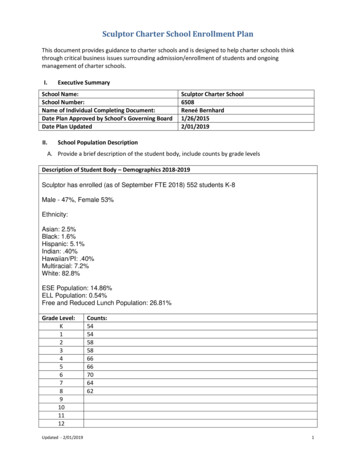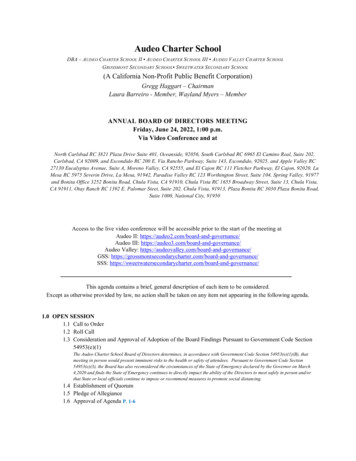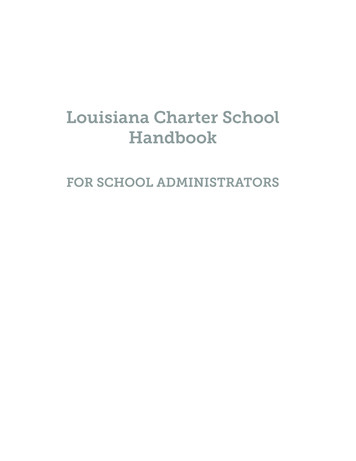
Transcription
Hoboken Dual Language Charter SchoolWellness PolicyTable of ContentsPreamble 2School Wellness Committee .3Wellness Policy Implementation, Monitoring,Accountability, and Community Engagement .4Nutrition .7Physical Activity .14Other Activities that Promote Student Wellness 18Glossary 20Appendix A: School Level Contacts .211HOBOKEN DUAL LANGUAGE CHARTER SCHOOL 123 JEFFERSON STREET HOBOKEN, NEW JERSEY 07030
Hoboken Dual Language Charter SchoolWellness PolicyPreambleHoboken Dual Language Charter School (hereto referred to as the District) is committed to theoptimal development of every student. The District believes that for students to have theopportunity to achieve personal, academic, developmental, and social success, we need tocreate positive, safe, and health-promoting learning environments at every level, in every setting,throughout the school year.Research shows that two components, good nutrition and physical activity before, during, andafter the school day, are strongly correlated with positive student outcomes. For example,student participation in the U.S. Department of Agriculture’s (USDA) School Breakfast Program isassociated with higher grades and standardized test scores, lower absenteeism, and betterperformance on cognitive tasks.1,2,3,4,5,6,7 Conversely, less-than-adequate consumption of specificfoods including fruits, vegetables, and dairy products, is associated with lower grades amongstudents.8,9,10 In addition, students who are physically active through active transport to and fromschool, recess, physical activity breaks, high-quality physical education, and extracurricularactivities – do better academically.11,12,13,14This policy outlines the District’s approach to ensuring environments and opportunities for allstudents to practice healthy eating and physical activity behaviors throughout the school daywhile minimizing commercial distractions. Specifically, this policy establishes goals andprocedures to ensure that: Students in the District have access to healthy foods throughout the school day—boththrough reimbursable school meals and other foods available throughout the schoolcampus—in accordance with Federal and state nutrition standards;Students receive quality nutrition education that helps them develop lifelong healthy eatingbehaviors;Students have opportunities to be physically active before, during, and after school;Schools engage in nutrition and physical activity promotion and other activities that promotestudent wellness;School staff are encouraged and supported to practice healthy nutrition and physical activitybehaviors in and out of school;The community is engaged in supporting the work of the District in creating continuitybetween school and other settings for students and staff to practice lifelong healthy habits;andThe District establishes and maintains an infrastructure for management, oversight,implementation, communication about, and monitoring of the policy and its established goalsand objectives.This policy applies to all students, staff, and schools in the District.2HOBOKEN DUAL LANGUAGE CHARTER SCHOOL 123 JEFFERSON STREET HOBOKEN, NEW JERSEY 07030
The District will coordinate the wellness policy with other aspects of school management,including the District’s School Improvement Plan, when appropriate.NOTE: Will also include any relevant data or statistics from state or local sources supportingthe need for establishing and achieving the goals in this policy. I.School Wellness CommitteeCommittee Role and MembershipThe District will convene a representative district wellness committee (hereto referred to as theDWC or work within an existing school health committee) that meets at least four times per yearto establish goals for and oversee school health and safety policies and programs, includingdevelopment, implementation, and periodic review and update of this district-level wellness policy(heretofore referred as “wellness policy”).The DWC membership will represent all school levels (elementary and secondary schools) andinclude (to the extent possible), but not be limited to: parents and caregivers; students;representatives of the school nutrition program (ex., school nutrition director); physical educationteachers; health education teachers; school health professionals (ex., health education teachers,school health services staff [i.e., nurses, physicians, dentists, health educators, and other alliedhealth personnel who provide school health services], and mental health and social services staff[i.e., school counselors, psychologists, social workers, or psychiatrists]; school administrators(ex., superintendent, principal, vice principal), school board members; health professionals (ex.,dietitians, doctors, nurses, dentists); and the general public. To the extent possible, the DWC willinclude representatives from each school building and reflect the diversity of the community. Each school within the District will establish an ongoing School Wellness Committee (SWC)that convenes to review school-level issues, in coordination with the DWC.LeadershipThe Superintendent or designee(s) will convene the DWC and facilitate development of andupdates to the wellness policy, and will ensure each school’s compliance with the policy. Thenames, titles, and contact information are:NameTitleEmail addressRoleJen SargentExecutive Directorjsargent@holahoboken.orgConsultantMarta PizarroFood affa CohenSchool Nurseycohen@holahobken.orgConsultantBarbara MartinezBoard PresidentBmartinez1125@gmail.comConsultant3HOBOKEN DUAL LANGUAGE CHARTER SCHOOL 123 JEFFERSON STREET HOBOKEN, NEW JERSEY 07030
Each school will designate a school wellness policy coordinator, who will ensure compliance withthe policy. Refer to Appendix A for a list of school level wellness policy coordinators.II.Wellness Policy Implementation, Monitoring, Accountability, andCommunity EngagementImplementation PlanThe District will develop and maintain a plan for implementation to manage and coordinate theexecution of this wellness policy. The plan delineates roles, responsibilities, actions, and timelinesspecific to each school, and includes information about who will be responsible to make whatchange, by how much, where, and when, as well as specific goals and objectives for nutritionstandards for all foods and beverages available on the school campus, food and beveragemarketing, nutrition promotion and education, physical activity, physical education, and otherschool-based activities that promote student wellness. It is recommended that the school use theHealthy Schools Program online tools to complete a school level assessment based on theCenters for Disease Control and Prevention’s School Health Index, create an action plan thatfosters implementation, and generate an annual progress report.This wellness policy and the progress reports can be found gThe District will retain records to document compliance with the requirements of the wellnesspolicy at 123 Jefferson Street, Hoboken, New Jersey 07030. Documentation maintained in thislocation will include but will not be limited to: The written wellness policy;Documentation demonstrating compliance with community involvement requirements,including (1) Efforts to actively solicit DWC membership from the required stakeholdergroups; and (2) These groups’ participation in the development, implementation, and periodicreview and update of the wellness policy;Documentation of annual policy progress reports for each school under its jurisdiction; andDocumentation of the triennial assessment* of the policy for each school under its jurisdiction;Documentation demonstrating compliance with public notification requirements, including: (1)Methods by which the wellness policy, annual progress reports, and triennial assessmentsare made available to the public; and (2) Efforts to actively notify families about theavailability of wellness policy.Annual Progress ReportsThe District will compile and publish an annual report to share basic information about thewellness policy and report on the progress of the schools within the district in meeting wellnessgoals. This annual report will be published around the same time each year, and will includeinformation from each school within the District. This report will include, but is not limited to:4HOBOKEN DUAL LANGUAGE CHARTER SCHOOL 123 JEFFERSON STREET HOBOKEN, NEW JERSEY 07030
The website address for the wellness policy and/or how the public can receive/access a copyof the wellness policy;A description of each school’s progress in meeting the wellness policy goals;A summary of each school's events or activities related to wellness policy implementation;The name, position title, and contact information of the designated District policy leader(s)identified in Section I; andInformation on how individuals and the public can get involved with the DWC or SWC.The annual report will be available in English and Spanish.The District will actively notify households/families of the availability of the annual report.The DWC, will establish and monitor goals and objectives for the District’s schools, specific andappropriate for each instructional unit (elementary or secondary OR elementary, middle, and highschool, as appropriate), for each of the content-specific components listed in Sections III-V of thispolicy. The District will track, analyze, and report on any correlations between improvements inhealth-promoting environments with education outcomes, such as absenteeism, disciplinaryreferrals, test scores, average grades, or health measures such as consumption of wholegrains, fruits, or vegetables through the school meal programs or BMI, or psycho-socialmeasures such as self-reported “connectedness,” or other school climate measures. TheDistrict is encouraged to collaborate with local research institutions and universities.The District will also track and annually report other related information, such as findings fromfood safety inspections, aggregate participation in school meals programs, income reportedfrom competitive food sales, fundraising revenues, and other such information, as feasible.]Triennial Progress AssessmentsAt least once every three years, the District will evaluate compliance with the wellness policy toassess the implementation of the policy and include: The extent to which schools under the jurisdiction of the District are in compliance with thewellness policy;The extent to which the District’s wellness policy compares to the Alliance for a HealthierGeneration’s model wellness policy; andA description of the progress made in attaining the goals of the District’s wellness policy.The position/person responsible for managing the triennial assessment and contact information isJen Sargent, Executive Director, jsargent@holahoboken.org.The DWC, in collaboration with individual schools, will monitor schools’ compliance with thiswellness policy.Hoboken Dual Language Charter School will actively notify households/families of the availabilityof the triennial progress report.Revisions and Updating the Policy5HOBOKEN DUAL LANGUAGE CHARTER SCHOOL 123 JEFFERSON STREET HOBOKEN, NEW JERSEY 07030
The DWC will update or modify the wellness policy based on the results of the annual progressreports and triennial assessments, and/or as District priorities change; community needs change;wellness goals are met; new health science, information, and technology emerges; and newFederal or state guidance or standards are issued. The wellness policy will be assessed andupdated as indicated at least every three years, following the triennial assessment.Community Involvement, Outreach, and CommunicationsThe District is committed to being responsive to community input, which begins with awareness ofthe wellness policy. The District will actively communicate ways in which representatives ofDWC and others can participate in the development, implementation, and periodic review andupdate of the wellness policy through a variety of means appropriate for that district. The Districtwill also inform parents of the improvements that have been made to school meals andcompliance with school meal standards, availability of child nutrition programs and how to apply,and a description of and compliance with Smart Snacks in School nutrition standards. TheDistrict will use electronic mechanisms, such as email or displaying notices on the district’swebsite, as well as non-electronic mechanisms, such as newsletters, presentations to parents, orsending information home to parents, to ensure that all families are actively notified of the contentof, implementation of, and updates to the wellness policy, as well as how to get involved andsupport the policy. The District will ensure that communications are culturally and linguisticallyappropriate to the community, and accomplished through means similar to other ways that thedistrict and individual schools are communicating other important school information with parents.The District will actively notify the public about the content of or any updates to the wellnesspolicy annually, at a minimum. The District will also use these mechanisms to inform thecommunity about the availability of the annual and triennial reports.III.NutritionSchool MealsOur school district is committed to serving healthy meals to children, with plenty of fruits,vegetables, whole grains, and fat-free and low-fat milk; moderate in sodium, low in saturated fat,and zero grams trans fat per serving (nutrition label or manufacturer’s specification); and to meetthe nutrition needs of school children within their calorie requirements. The school meal programsaim to improve the diet and health of school children, help mitigate childhood obesity, modelhealthy eating to support the development of lifelong healthy eating patterns, and support healthychoices while accommodating cultural food preferences and special dietary needs.All schools within the District participate in USDA child nutrition programs, including the NationalSchool Lunch Program (NSLP), the School Breakfast Program (SBP). All schools within theDistrict are committed to offering school meals through the NSLP and SBP programs, and otherapplicable Federal child nutrition programs, that: Are accessible to all students;Are appealing and attractive to children;Are served in clean and pleasant settings;6HOBOKEN DUAL LANGUAGE CHARTER SCHOOL 123 JEFFERSON STREET HOBOKEN, NEW JERSEY 07030
Meet or exceed current nutrition requirements established by local, state, and Federalstatutes and regulations. (The District offers reimbursable school meals that meet USDAnutrition standards.)Promote healthy food and beverage choices using at least ten of the following SmarterLunchroom techniques: Whole fruit options are displayed in attractive bowls or baskets (instead of chaffing dishesor hotel pans) Sliced or cut fruit is available daily Daily fruit options are displayed in a location in the line of sight and reach of students All available vegetable options have been given creative or descriptive names Daily vegetable options are bundled into all grab and go meals available to students All staff members, especially those serving, have been trained to politely prompt studentsto select and consume the daily vegetable options with their meal White milk is placed in front of other beverages in all coolers Alternative entrée options (e.g., salad bar, yogurt parfaits, etc.) are highlighted on postersor signs within all service and dining areas A reimbursable meal can be created in any service area available to students (e.g., saladbars, snack rooms, etc.) Student surveys and taste testing opportunities are used to inform menu development,dining space decor, and promotional ideas Student artwork is displayed in the service and/or dining areas Daily announcements are used to promote and market menu optionsMenus will be posted on the District website or individual school websites, and will includenutrient content and ingredients.Menus will be created/reviewed by a Registered Dietitian or other certified nutritionprofessional.School meals are administered by a team of child nutrition professionals.The District child nutrition program will accommodate students with special dietary needs.Students will be allowed at least 10 minutes to eat breakfast and at least 20 minutes to eatlunch, counting from the time they have received their meal and are seated (meets HSP Goldlevel). Students are served lunch at a reasonable and appropriate time of day.Lunch will follow the recess period to better support learning and healthy eating.Participation in Federal child nutrition programs will be promoted among students andfamilies to help ensure that families know what programs are available in their children’sschool.The District will implement at least four of the following five Farm to School activities (meetsHSP Gold level; mark/circle the four activities the District plans to do): Local and/or regional products are incorporated into the school meal program; Messages about agriculture and nutrition are reinforced throughout the learningenvironment; School hosts a school garden; School hosts field trips to local farms; and School utilizes promotions or special events, such as tastings, that highlight the local/regional products.]Staff Qualifications and Professional DevelopmentAll school nutrition program directors, managers, and staff will meet or exceed hiring and annualcontinuing education/training requirements in the USDA professional standards for child nutrition7HOBOKEN DUAL LANGUAGE CHARTER SCHOOL 123 JEFFERSON STREET HOBOKEN, NEW JERSEY 07030
professionals. These school nutrition personnel will refer to USDA’s Professional Standards forSchool Nutrition Standards website to search for training that meets their learning needs.WaterTo promote hydration, free, safe, unflavored drinking water will be available to all studentsthroughout the school day* and throughout every school campus* (“school campus” and “schoolday” are defined in the glossary). The District will make drinking water available where schoolmeals are served during mealtimes. In addition, students will be allowed to bring and carry(approved) water bottles filled with only water with them throughout the day. Water cups/jugs will be available in the cafeteria if a drinking fountain is not present.All water sources and containers will be maintained on a regular basis to ensure goodhygiene standards. Such sources and containers may include drinking fountains, water jugs,hydration stations, water jets, and other methods for delivering drinking water.]Competitive Foods and BeveragesThe District is committed to ensuring that all foods and beverages available to students on theschool campus* during the school day* support healthy eating. The foods and beverages soldand served outside of the school meal programs (i.e., “competitive” foods and beverages) willmeet the USDA Smart Snacks in School nutrition standards, at a minimum. Smart Snacks aim toimprove student health and well-being, increase consumption of healthful foods during the schoolday, and create an environment that reinforces the development of healthy eating habits. Asummary of the standards and information are available s-schools-smart-snacks. The Alliance for aHealthier Generation provides a set of tools to assist with implementation of Smart Snacksavailable at www.healthiergeneration.org/smartsnacks.To support healthy food choices and improve student health and well-being, all foods andbeverages outside the reimbursable school meal programs that are sold to students on the schoolcampus during the school day will meet or exceed the USDA Smart Snacks nutrition standards.These standards will apply in all locations and through all services where foods and beveragesare sold, which may include, but are not limited to, a la carte options in cafeterias, vendingmachines, school stores, and snack or food carts.Celebrations and RewardsAll foods offered on the school campus will meet or exceed the USDA Smart Snacks in Schoolnutrition standards, including through:1. Celebrations and parties. The district will provide a list of healthy party ideas to parents andteachers, including non-food celebration ideas. Healthy party ideas from the Alliance for aHealthier Generation and from the USDA.2. Classroom snacks brought by parents. The District will provide to parents a list of foods andbeverages that meet Smart Snacks nutrition standards; and3. Rewards and incentives. The District will provide teachers and other relevant school staff alist of alternative ways to reward children. Foods and beverages will not be used as a reward,8HOBOKEN DUAL LANGUAGE CHARTER SCHOOL 123 JEFFERSON STREET HOBOKEN, NEW JERSEY 07030
or withheld as punishment for any reason, such as for performance or behavior.[Meets HSP Silver]FundraisingFoods and beverages that meet or exceed the USDA Smart Snacks in Schools nutritionstandards may be sold through fundraisers on the school campus* during the school day*. TheDistrict will make available to parents and teachers a list of healthy fundraising ideas [examplesfrom the Alliance for a Healthier Generation and the USDA]. Schools will use only non-food fundraisers, and encourage those promoting physical activity(such as walk-a-thons, jump rope for heart, fun runs, etc.).Fundraising during and outside school hours will sell only non-food items or foods andbeverages that meet or exceed the Smart Snacks nutrition standards. This may include but isnot limited to, donation nights at restaurants, cookie dough, candy and pizza sales, marketdays, etc.Nutrition PromotionNutrition promotion and education positively influence lifelong eating behaviors by usingevidence-based techniques and nutrition messages, and by creating food environments thatencourage healthy nutrition choices and encourage participation in school meal programs.Students and staff will receive consistent nutrition messages throughout schools, classrooms,gymnasiums, and cafeterias. Nutrition promotion also includes marketing and advertisingnutritious foods and beverages to students and is most effective when implemented consistentlythrough a comprehensive and multi-channel approach by school staff and teachers, parents,students, and the community.The District will promote healthy food and beverage choices for all students throughout the schoolcampus, as well as encourage participation in school meal programs. This promotion will occurthrough at least: Implementing evidence-based healthy food promotion techniques through the school mealprograms using Smarter Lunchroom techniques; andPromoting foods and beverages that meet the USDA Smart Snacks in School nutritionstandards. Additional possible promotion techniques that the District and individual schoolsmay use are available at www.healthiergeneration.org/smartsnacks.Nutrition EducationThe District aims to teach, model, encourage, and support healthy eating by students. Schoolswill provide nutrition education and engage in nutrition promotion that: Is designed to provide students with the knowledge and skills necessary to promote andprotect their health;Is part of not only health education classes, but also integrated into other classroominstruction through subjects such as math, science, language arts, social sciences, andelective subjects;9HOBOKEN DUAL LANGUAGE CHARTER SCHOOL 123 JEFFERSON STREET HOBOKEN, NEW JERSEY 07030
Include enjoyable, developmentally-appropriate, culturally-relevant, and participatoryactivities, such as cooking demonstrations or lessons, promotions, taste-testing, farm visits,and school gardens;Promote fruits, vegetables, whole-grain products, low-fat and fat-free dairy products, andhealthy food preparation methods;Emphasize caloric balance between food intake and energy expenditure (promotes physicalactivity/exercise);Link with school meal programs, cafeteria nutrition promotion activities, school gardens, Farmto School programs, other school foods, and nutrition-related community services;Teach media literacy with an emphasis on food and beverage marketing; andInclude nutrition education training for teachers and other staff.In elementary schools, nutrition education will be offered at each grade level as part of asequential, comprehensive, standards-based health education curriculum that meets stateand national standardsAll health education teachers will provide opportunities for students to practice or rehearsethe skills taught through the health education curriculaEssential Healthy Eating Topics in Health EducationThe District will include in the health education curriculum the following essential topics onhealthy eating: The relationship between healthy eating and personal health and disease preventionFood guidance from MyPlateReading and using USDA's food labelsEating a variety of foods every dayBalancing food intake and physical activityEating more fruits, vegetables, and whole grain productsChoosing foods that are low in fat, saturated fat, and cholesterol and do not contain trans fatChoosing foods and beverages with little added sugarsEating more calcium-rich foodsPreparing healthy meals and snacksRisks of unhealthy weight control practicesAccepting body size differencesFood safetyImportance of water consumptionImportance of eating breakfastMaking healthy choices when eating at restaurantsEating disordersThe Dietary Guidelines for AmericansReducing sodium intakeSocial influences on healthy eating, including media, family, peers, and cultureHow to find valid information or services related to nutrition and dietary behaviorHow to develop a plan and track progress toward achieving a personal goal to eat healthfullyResisting peer pressure related to unhealthy dietary behaviorInfluencing, supporting, or advocating for others’ healthy dietary behaviorUSDA’s Team Nutrition provides free nutrition education and promotion materials, includingstandards-based nutrition education curricula and lesson plans, posters, interactive games, menugraphics, and more.10HOBOKEN DUAL LANGUAGE CHARTER SCHOOL 123 JEFFERSON STREET HOBOKEN, NEW JERSEY 07030
Food and Beverage Marketing in SchoolsThe District is committed to providing a school environment that ensures opportunities for allstudents to practice healthy eating and physical activity behaviors throughout the school daywhile minimizing commercial distractions. The District strives to teach students how to makeinformed choices about nutrition, health, and physical activity. These efforts will be weakened ifstudents are subjected to advertising on District property that contains messages inconsistentwith the health information the District is imparting through nutrition education and healthpromotion efforts. It is the intent of the District to protect and promote student’s health bypermitting advertising and marketing for only those foods and beverages that are permitted to besold on the school campus, consistent with the District’s wellness policy.Any foods and beverages marketed or promoted to students on the school campus* during theschool day* will meet or exceed the USDA Smart Snacks in School nutrition standards, such thatonly those foods that comply with or exceed those nutrition standards are permitted to bemarketed or promoted to students.Food advertising and marketing is defined15 as an oral, written, or graphic statements made forthe purpose of promoting the sale of a food or beverage product made by the producer,manufacturer, seller, or any other entity with a commercial interest in the product. This termincludes, but is not limited to the following: Brand names, trademarks, logos or tags, except when placed on a physically present food orbeverage product or its container.Displays, such as on vending machine exteriors.Corporate brand, logo, name, or trademark on school equipment, such as marquees,message boards, scoreboards, or backboards (Note: immediate replacement of these itemsare not required; however, districts will consider replacing or updating scoreboards or otherdurable equipment over time so that decisions about the replacement include compliancewith the marketing policy.)Corporate brand, logo, name, or trademark on cups used for beverage dispensing, menuboards, coolers, trash cans, and other food service equipment; as well as on posters, bookcovers, pupil assignment books, or school supplies displayed, distributed, offered, or sold bythe District.Advertisements in school publications or school mailings.Free product samples, taste tests, or coupons of a product, or free samples displayingadvertising of a product.IV.Physical ActivityChildren and adolescents should participate in 60 minutes of physical activity every day. Asubstantial percentage of students’ physical activity can be provided through a comprehensive,11HOBOKEN DUAL LANGUAGE CHARTER SCHOOL 123 JEFFERSON STREET HOBOKEN, NEW JERSEY 07030
school-based physical activity program (CSPAP) that includes these components: physicaleducation, recess, classroom-based physical activity, walk and bicycle to school, and out-ofschool time activities and the district is committed to providing these opportunities. Schools willensure that these varied opportunities are in addition to, and not as a substitute for, physicaleducation (addressed in “Physical Education” subsection). All schools in the district will beencouraged to participate in Let’s Move! Active Schools (www.letsmoveschools.org) in order tosuccessfully address all CSPAP areas.Physical ac
HOBOKEN DUAL LANGUAGE CHARTER SCHOOL 123 JEFFERSON STREET HOBOKEN, NEW JERSEY 07030 3 The District will coordinate the wellness policy with other aspects of school management, including the District's School Improvement Plan, when appropriate. NOTE: Will also include any relevant data or statistics from state or local sources supporting

